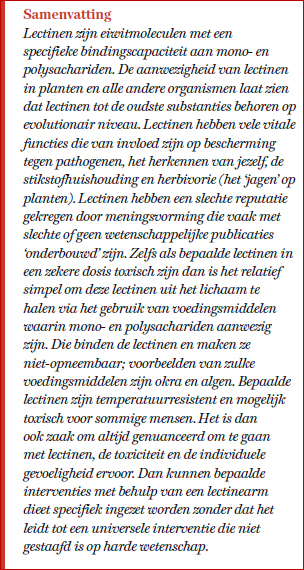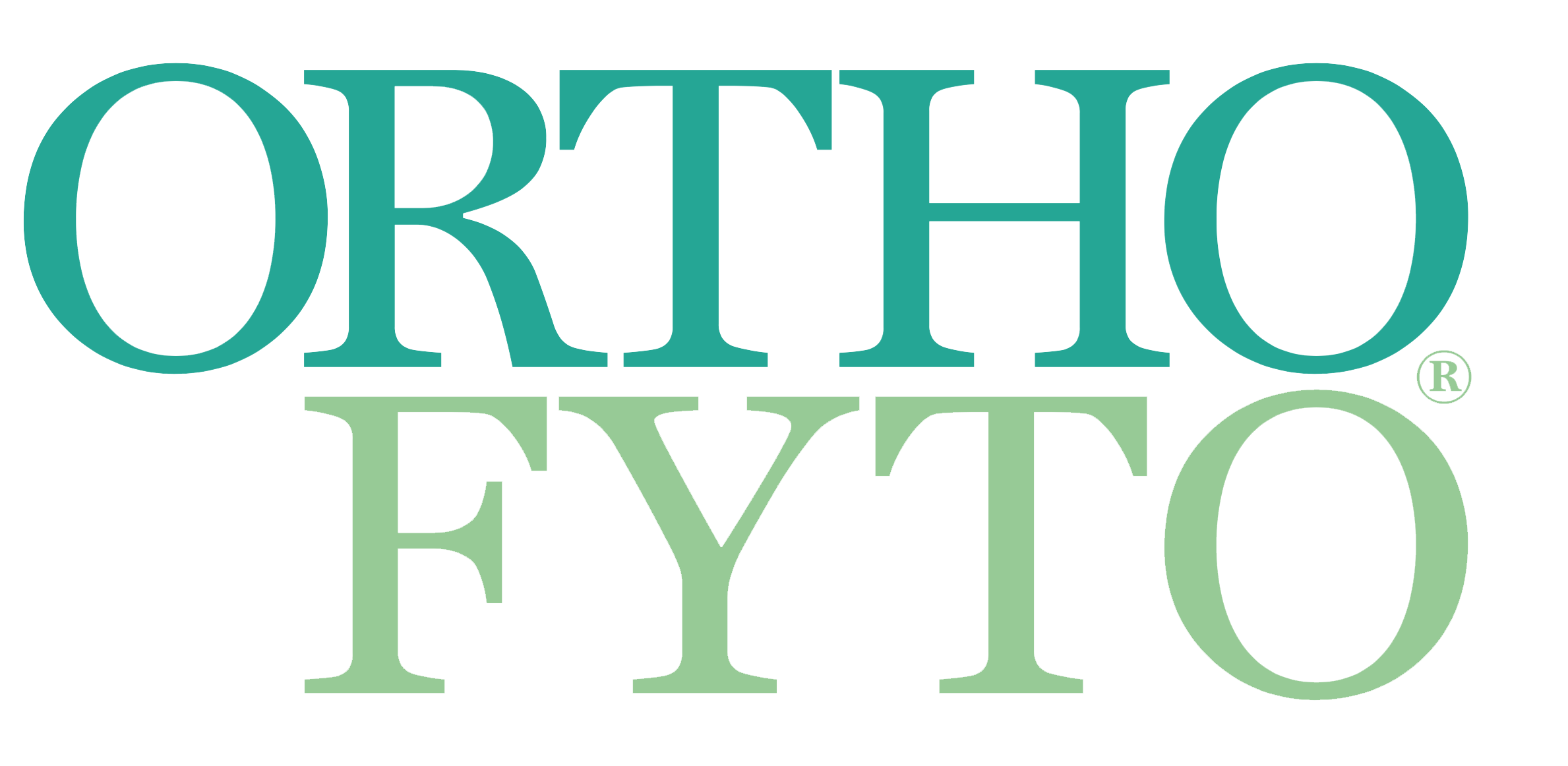Plantenlectinen: vrienden of vijanden?
13 Jun, 2019
Door: Leo Pruimboom

De mogelijke toxiciteit van lectinen in bepaalde voedingsmiddelen is, na veertig jaar, in de populaire pers opnieuw een hype. Lectine-vrije diëten worden aanbevolen voor een hele rij mensen die aan auto-immuunziekten lijden, maar ook als universele preventieve interventie. In hoeverre deze diëten op wetenschappelijk bewijs steunen is twijfelachtig; daarom hier een kort overzicht van de huidige wetenschappelijke kennis over de mogelijke voor en tegens van het eten van voedingsmiddelen die rijk zijn aan verschillende lectinen.
Lectinen zijn eiwitmoleculen die specifiek binden aan bepaalde monosachariden of polysachariden; ze zijn aanwezig in vrijwel alle levende organismen, waaronder planten en mensen, en worden geproduceerd door verschillende celtypen. Het woord lectine komt van het woord legere, dat letterlijk kiezen betekent. De functies van lectinen komen voort uit hun capaciteit om specifieke suikers te binden en de locatie waar ze aanwezig zijn. Lectinen kunnen worden geclassificeerd op basis van hun structuur, functie en expressiepatroon.
De groep lectinen die het meest voorkomt in planten heeft vooral een voorraadfunctie voor het leveren van stikstof en bepaalde aminozuren aan de plant; die lectinen zijn dan ook vooral te vinden in speciale plantendelen zoals het zaad dat, ten behoeve van potentiële voortplanting, direct gevoed dient te worden. Het feit dat ze ook aanwezig zijn in de extracellulaire ruimte doet vermoeden dat ze een belangrijk onderdeel zijn van het plantafweersysteem en het zaad beschermen tegen ziekte, pathogenen en herbivorie (vraat).1
Naast deze structureel en rijk aanwezige lectinen bestaan er andere die geproduceerd worden onder abiotische en biotische stressomstandigheden. Deze groep proteïnen is vooral aanwezig in het cytoplasma en de kern van de cel en beschermt de plant tegen factoren zoals koude, hitte, uitdroging en pathogenen via de activatie van het stress-systeem van de plant, waaronder het immuunsysteem.2 Ook dieren hebben zowel structurele als stimuleerbare lectinen, waarbij opgemerkt dient te worden dat de functies voor een deel verschillen van plantenlectinen en voor een deel dezelfde rol hebben binnen het afweersysteem. Samengevat worden lectinen onderverdeeld in twaalf plantenfamilies en veertien dierenfamilies.
Lees het gehele artikel vanaf pagina 28 in OrthoFyto 3/19
Wilt u het hele artikel als PDF bestand ontvangen? Bestel het dan hier voor € 3,50
Bronvermelding:
- Kristof De Schutter and Els J. M. Van Damme. Protein-Carbohydrate Interactions as Part of Plant Defense and Animal Immunity. Molecules 2015, 20, 9029-9053
- Van Damme, E.J.M.; Barre, A.; Rougé, P.; Peumans, W.J. Cytoplasmic/nuclear plant lectins: A new story. Trends Plant Sci. 2004, 9, 484–489
- Ajit Varki and Pascal Gagneux. Multifarious roles of sialic acids in immunity. Ann. N.Y. Acad. Sci. 1253 (2012) 16–36).
- Byrne, B., G.G. Donohoe & R. O’Kennedy. 2007. Sialic acids: carbohydrate moieties that influence the biological and physical properties of biopharmaceutical proteins and living cells. Drug Discov. Today 12: 319–326.
- Loren Cordain, L. Toohey, M. J. Smith and M. S. Hickey. Modulation of immune function by dietary lectins in rheumatoid arthritis. British Journal of Nutrition (2000), 83, 207–217
- Brady PG, Vannier AM & Banwell JG (1978) Identification of the dietary lectin, wheat germ agglutinin, in human intestinal contents. Gastroenterology 75, 236–239).
- Grant G, More LJ, McKenzie NH & Pusztai A (1982) The effect of heating on the haemagglutinating activity and nutritional properties of bean (Phaseolus vulgaris) seeds. Journal of the Science of Food and Agriculture 33, 1324–1326
- Zheng J, Wang M, Wei W, Keller JN, Adhikari B, King JF, King ML, Peng N and Laine RA (2016) Dietary Plant Lectins Appear to Be Transported from the Gut to Gain Access to and Alter Dopaminergic Neurons of Caenorhabditis elegans, a Potential Etiology of Parkinson’s Disease. Front. Nutr. 3:7
- Ryva B, Zhang K, Asthana A, Wong D, Vicioso Y and Parameswaran R (2019) Wheat Germ Agglutinin as a Potential Therapeutic Agent for Leukemia. Front. Oncol. 9:100
- Ricci-Azevedo R, Roque-Barreira MC, Gay NJ. Targeting and recognition of toll-like receptors by plant and pathogen lectins. Front Immunol. (2017) 8:1820.
- Ricin, Brown, Jonathan (20 June 2008),‘Poison umbrella murder case is reopened’,The Independent, UK, retrieved 20 November 2009
- Freed, David LJ. Do dietary lectins cause disease? BMJ volume 318 17 april 1999
- Karin de Punder and Leo Pruimboom. The Dietary Intake of Wheat and other Cereal Grains and Their Role in Inflammation. Nutrients 2013, 5, 771-787.
- Lambert and Vojdani. Correlation of Tissue Antibodies and Food Immune Reactivity in Randomly Selected Patient Specimens. J Clin Cell Immunol 2017, 8:5
- Freed DLJ (2002) Chapter 34: Dietary lectins and disease. In Food Allergy and Intolerance, 2nd Edition, Brostoff J and Challacombe SJ, eds, Saunders Ltd, London, pp 479-488
- Irlanda Lagarda-Diaz, Ana Maria Guzman-Partida and Luz Vazquez-Moreno. Legume Lectins: Proteins with Diverse Applications. Int. J. Mol. Sci. 2017, 18, 124218.
- Sammour, R.H.; El-Shanshoury, A. Antimicrobial activity of legume seed proteins. Bot. Bull. Acad. Sin. 1992, 31, 185–190
- Hansen, J.E.; Nielsen, C.M.; Nielsen, C.; Heegaard, P.; Mathiesen, L.R.; Nielsen, J.O. Correlation between carbohydrate structures on the envelope glycoprotein gp120 of HIV-1 and HIV-2 and syncytium inhibition with lectins. Aids 1989, 3, 635–641.
- Leo Pruimboom, Frits A.J. Muskiet. Intermittent living; the use of ancient challenges as a vaccine against the deleterious effects of modern life – A hypothesis. Medical Hypotheses 120 (2018) 28–42).
- Rabia Hamid and Akbar Masood, 2009. Dietary Lectins as Disease Causing Toxicants. Pakistan Journal of Nutrition, 8: 293-303.
